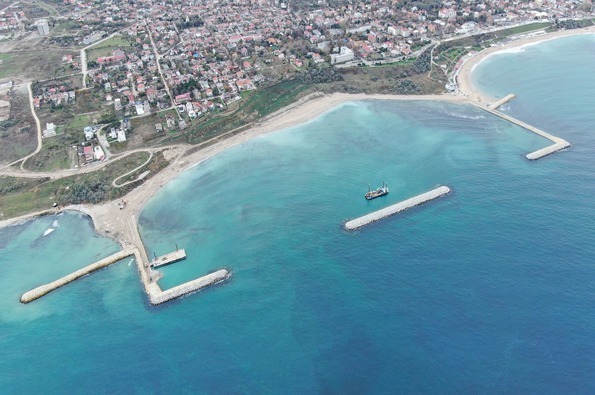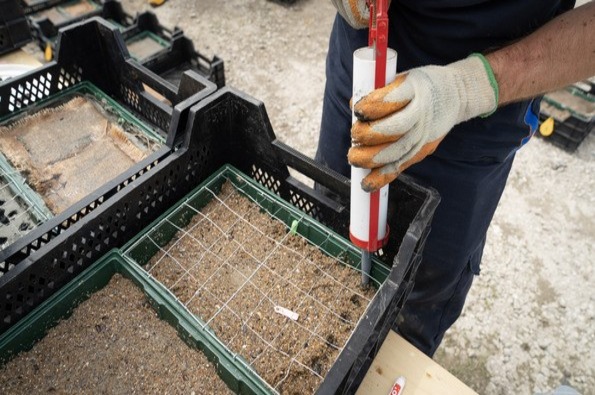Engineering resilient and sustainable coastlines

Coastal protection at Eforie, Romania. Credit: Van Oord
Romania’s Black Sea coast is a popular tourist spot, with its long beaches being a particular draw in the summertime. As part of ongoing efforts to enhance the resilience of the region’s resorts and beaches against coastal erosion, flooding and severe weather events, the Dobrogea-Litoral Water Basin Administration (ABA-DL) awarded three new contracts to Van Oord in November 2023.
With a combined value of approximately EUR 200 million, the contracts are for 6.7 kilometres of new coastal defences at the Black Sea resorts of Costinesti, Mangalia-Saturn, and 2 Mai. The scope of work includes designing and constructing new groynes and beaches, removing and redeveloping some of the existing breakwaters, and enhancing marine habitats with seagrass, artificial reefs and biostructures.
Working with nature
Until recently, the only way to protect Romania's coastline and maintain its economic value was through hard-engineered structures (grey infrastructure). However, Marius Stamat, Branch Manager from Van Oord told CEDA Industry News (CIN) that, in many instances, they “urgently require extended protection works as the existing structures are around 50 years old and in an advanced state of degradation.”
Climate change is compounding the situation, as more frequent coastal flooding and storm surges impact coastal morphology, further stress-testing the ageing sea defences. Pieter van der Klis, Engineering Manager explained to CIN: ” The impact of climate change … led authorities to consider the necessity of creating a new scheme of coastal protection which considers these changes to protect the resorts for years to come.”
To satisfy the lifetime parameters set by ABA-DL for the new contracts, hydrographic conditions, including wave conditions, currents and water level developments caused by storms and climate change, must be thoroughly analysed before designing offshore breakwaters, groynes and beaches.
Van Oord, which has executed numerous innovative projects along Romania’s coast since 2013, has a strong knowledge of the local conditions. “Special attention is paid to the design of the beaches. The shape of the beach, the layout of the rock structures and the creation of the right conditions for marine habitats have a complex interaction and cannot be designed in isolation. It requires good coordination between all design disciplines and the authorities,” noted van der Klis. Upon completion of the latest contract, Van Oord will have reinforced over 26km, or almost 11%, of the country’s coastline. This accounts for “about 75% of total coastal protection works the authorities had in plan to execute” added Stamat.
The new contracts also specify that the beaches need to be maintenance-free, which may have posed a challenge for providers with less experience than Van Oord. “Through our design work, we have gathered a lot of knowledge on the behaviour of the beaches. The most important lesson learned was recognising and accounting for the strong interaction between beaches, structures and environment,” van der Klis told CIN.
The company’s use of nature-based solutions (NbS) such as building with nature, engineering with nature and ecosystem-based adaptation was the key to securing multiple ABA-DL contracts. Such solutions integrate natural features and processes (green infrastructure) with grey infrastructure techniques to produce more sustainable, reliable, and cost-effective designs than traditional engineered solutions.
Overcoming challenges
Adopting NbS approaches poses challenges. Lack of sufficient data and knowledge of baseline conditions, uncertainty and variability of natural processes - such as hydrodynamics, sediment transport, and climate change - and the long-term effects of projects can ultimately affect the performance and resilience of the works. Furthermore, complex and diverse stakeholder interests, preferences, and expectations can create conflicts that make it more difficult for projects to deliver desired outcomes. NbS projects can also incur higher capital costs as they require specialised skills, equipment and materials and require regular monitoring and evaluation.
To compound matters, van der Klis also outlined how: “Each stretch of the coast has unique characteristics in soils, bathymetry and exposure to the sea and swell and needs a bespoke solution for each location”. To overcome such issues, Van Oord’s approach incorporated extensive research and analysis on site-specific conditions, wide collaboration, and the use of innovative and flexible techniques, such as numerical modelling, physical testing, and real-time monitoring, to optimise the design and construction of its projects.
The company achieved notable NbS success Eforie, planting three hectares of seagrass beds using methods based on data about seagrass rehabilitation gathered via laboratory and field tests with the University of Groningen and The Fieldwork Company. In addition to restoring the marine habitat, seagrass is expected to reduce erosion and fortify the coast against flooding risks by stabilising the shoreline and increasing sediment retention. Van Oord also placed artificial reefs and biostructures on the sea bed to increase the productivity of the marine ecosystem.
Completed in 2023, the NbS work should protect Eforie’s coast for at least 50 years while creating attractive beaches and revitalising water-based activities for tourists, thus benefiting the local economy. The project has already proven popular with ABA-DL - which oversees approximately 230 hectares of tourist beaches along the Black Sea coast - and local communities. The solution also contributes to broader sustainability objectives as seagrasses rank amongst the most efficient natural carbon sinks. Sequestering carbon dioxide through photosynthesis, they are up to 40 times more efficient at capturing organic carbon than soils beneath land forests.
The proposed works
To enhance the resilience of the coastline at Costinesti, Mangalia-Saturn and 2 Mai, Van Oord will remove several of the existing breakwaters to make way for more environment-friendly alternatives and replenish the beaches. Using Eforie as a blueprint, the company will use specialised land-based equipment, which has sufficient reach and lifting capacity to install rocks at the toe of the structures and heavy concrete armour units, to construct the new breakwaters. It will then deploy two trailing suction hopper dredgers, Utrecht and HAM 318, to nourish and profile the beaches. The sand will be collected from a nearby borrow area, pumped ashore via offshore sinker lines, and distributed over the design profile by bulldozers. Over time, daily wave conditions and storms will naturally shape the beach, and its profile will show seasonal variations.

Seagrass seeding. Credit: Van Oord
Completed in 2023, the NbS work should protect Eforie’s coast for at least 50 years while creating attractive beaches and revitalising water-based activities for tourists, thus benefiting the local economy. The project has already proven popular with ABA-DL - which oversees approximately 230 hectares of tourist beaches along the Black Sea coast - and local communities. The solution also contributes to broader sustainability objectives as seagrasses rank amongst the most efficient natural carbon sinks. Sequestering carbon dioxide through photosynthesis, they are up to 40 times more efficient at capturing organic carbon than soils beneath land forests.
The proposed works
To enhance the resilience of the coastline at Costinesti, Mangalia-Saturn and 2 Mai, Van Oord will remove several of the existing breakwaters to make way for more environment-friendly alternatives and replenish the beaches. Using Eforie as a blueprint, the company will use specialised land-based equipment, which has sufficient reach and lifting capacity to install rocks at the toe of the structures and heavy concrete armour units, to construct the new breakwaters. It will then deploy two trailing suction hopper dredgers, Utrecht and HAM 318, to nourish and profile the beaches. The sand will be collected from a nearby borrow area, pumped ashore via offshore sinker lines, and distributed over the design profile by bulldozers. Over time, daily wave conditions and storms will naturally shape the beach, and its profile will show seasonal variations.
As part of the work scope, over 64 hectares of seagrass and algae will be replanted to enhance the marine environment, and seeding will commence after the construction phase. Having observed the results from the Eforie project, the company will transplant sods from an existing seagrass area, construct artificial reefs to create new marine habitats and install bio-structures for a species of algae and bivalve molluscs to enhance biodiversity.
Delivering success
Van Oord‘s collaborative and innovative approach has yielded results that will be applied to future projects. During the design of the rock structures, the team developed an entirely new approach to predicting water level rise and wave conditions within the beach pockets. This improved the accuracy of its preliminary designs and saved precious resources. Once designed, scale models of the rock structures were physically tested in laboratories to prove their stability under storm conditions and their durability to meet ABA-DL’s specifications.
Following a year-long design phase, the construction of the breakwaters at Costinesti, Mangalia-Saturn and 2 Mai should start this year, with expected completion by the end of 2026. By project end, it anticipates that it will have placed, since 2013, around 6 million tons of rock and 11m cubic meters of concrete across 42 coastal structures to safeguard against future erosion and flooding. If the three projects follow the same trajectory as previous works, Van Oord will have also achieved its aim of empowering nature and communities.
While the advice given in this editorial content has been developed using the best information available, it is intended purely as guidance to be used at the user’s own risk. No responsibility is accepted by CEDA or by the Intent Communications Ltd or by any person, firm, corporation or organisation who or which has been in any way concerned with the furnishing of information or data, the compilation, publication or any translation, supply or sale of this Guidance for the accuracy of any information or advice given herein or for any omission herefrom or from any consequences whatsoever resulting directly or indirectly from compliance with or adoption of guidance contained therein even if caused by a failure to exercise reasonable care.